Why buildings are collapsing, taking lives

The debris of a nine-storey building that collapsed in Ruiru, Kiambu County in this picture taken on October 21, 2021.
What you need to know:
- Past incidents have shown that rarely do investigations into collapsed buildings result in successful prosecution.
- Most past cases have no clear record of action taken, and for the few that ended up in court, developers managed to have their way.
Graft and impunity in planning departments, and greed among developers has led to an increase in collapsing buildings across the country.
This explains why county officials wait for buildings to collapse before they rush to declare them unsafe.
As Kenyans await the outcome of investigations into the collapse of five-storey buildings in Gachie and Kinoo and a recent one in Membley, Ruiru, past incidents have shown that a majority of such efforts are rarely prosecuted successfully.
Most past cases have no clear record of action taken, and for the few that ended up in court, developers managed to have their way.
It’s perhaps such outcomes that have encouraged impunity among greedy investors and emboldened unethical professionals.
In 2016, Dorkami House and the adjacent Neighbours Heights, both in Juja, were declared to be posing grave danger to the public after allegedly developing major cracks on the floors and walls.
The Kiambu County Government sued the owner, Mr Robert Kamau Kamiti, for carrying out a development without an approved plan for Dorkami, and for failing to build Neighbours Heights in accordance with the approved plan, thereby compromising its structural integrity.
Lacked jurisdiction
The court ordered the two buildings to be demolished, but the developer appealed the ruling in 2018 and obtained stay orders. Justice Joel Ngugi later ruled that the court lacked jurisdiction to order demolition.
“In either case, jurisdiction lies, in the first instance, with the county government and not the court. It, therefore, follows that the demolition orders given by the court exceeded its jurisdiction and are improper,” the judge ruled.
The two buildings have since been retrofitted and occupied, amid unresolved concerns by neighbours.
When we reached out to Mr Kamau to ask about the buildings’ safety, he said his neighbours were jealous. He then promised to provide approvals from the county government but later resorted to issuing threats.
Though the developer later apologised for the threats and presented copies of letters allegedly clearing the two buildings for occupation, the Nation could not verify if the copies were genuine as calls to Kiambu director of communications Franklin Wambugu went unanswered.
In October 2009, a five-storey building under construction in Kiambu town collapsed, trapping workers under rubble and claiming 17 lives. No one was held accountable.
Mr Stephen Kimani Kamau, the owner, the engineer of the then Kiambu municipal council, the designer and the contractor were charged in a Kiambu court with causing the deaths.
They were acquitted three years later on grounds that the prosecution had failed to prove the case beyond reasonable doubt.
Lucrative criminal enterprise
The court reached that conclusion despite evidence showing that the building fell as a result of poor workmanship and had grave structural faults.
Preliminary findings on the cause of the collapse of the nine-storey building in Membley on October 17 show that the developer applied for a building permit in January this year but went ahead with construction without approvals.
“The probable cause of the failure was the foundation, but we are still going to establish the exact cause as we go forward,” said Margaret Ogai, CEO of the Engineers Board of Kenya (EBK).
Following the recent incidents, the National Construction Authority (NCA), EBK, and the Board of Registration of Architects and Quantity Surveyors (Boraqs) have jointly issued a 30-day notice to all developers to make sure they comply with regulations.
“It is unfortunate that we meet when buildings collapse like we are doing a post-mortem, and I think the question we should be asking ourselves is, how do we do the right thing?” Boraqs chief executive Mwongera Rukaria posed.
NCA estimates that over 200 Kenyans died between 1990 and 2019 in documented cases of buildings collapsing. Despite this, a 2018 building audit report from the agency revealed that piecemeal efforts had been made to address existing concerns.
Booming demand for housing in counties has created a lucrative criminal enterprise in planning departments, where unnecessary hurdles are established to force developers to part with bribes to get approvals. In one county in central Kenya, a former governor was accused of pocketing Sh8 million to clear a development.
Haphazard development
In another incident, a county official was awarded several acres to allow a multinational to put up a multi-billion shilling project.
“As demand... increased exponentially, the industry found itself faced with haphazard development, underscored by a lack of professional capacity to support the same,” the report notes.
Experts say there is a management challenge at the industry level, particularly the lack of coordinated regulatory efforts, leading to proliferation of quacks.
“An engineer is not just anyone who has a degree, it is someone who is tested,” EBK member Johnson Matu says. Developers seeking short-cuts engage non-registered professionals, he adds.
An earlier audit the President ordered after buildings collapsed in Nairobi cited poor workmanship as the main cause (51 cases observed). Substandard materials (40) and poor structural design (36) were also to blame.
Raul Figueroa, a PhD student at Carnegie Mellon University who studied Nairobi’s buildings, found that the quality of construction was poor across the city, but was more alarming in Buru Buru and Eastleigh.
Contractors were also found to be profiting from stealing steel and cement, thus responsible for weaknesses in their projects.





